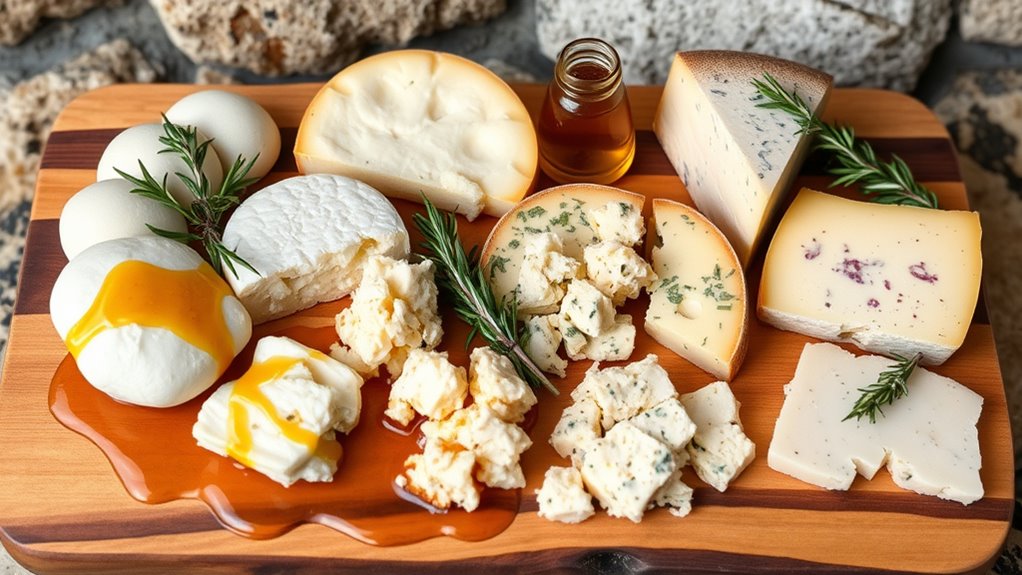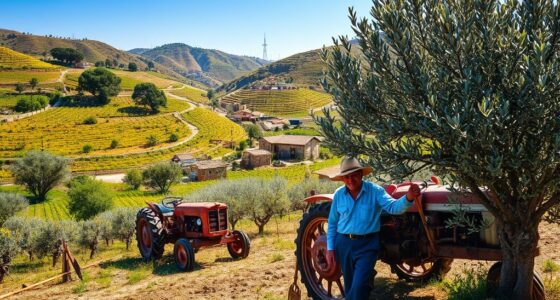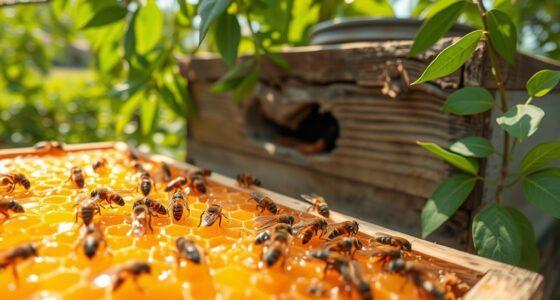Beyond pecorino, Sardinia offers a variety of unique cheeses like ricotta, which is made from whey and used in many local dishes. You’ll find casizolu, a pear-shaped cheese with a creamy or crumbly texture, and trizza, a fibrous, braided cheese from Oristano. Sardinia’s cheesemakers also produce fresh and aged varieties from sheep and goats, showcasing rich traditions and artisanal techniques. If you explore further, you’ll uncover even more about these fascinating flavors.
Key Takeaways
- Sardinia produces a variety of cheeses including fresh, semi-hard, and aged types like Ricotta, Casu Axedu, and Casizolu.
- Traditional Sardinian cheeses often use sheep, goat, or cow milk, with unique regional affinities and artisanal methods.
- Casu Axedu features both fresh and mature versions, with flavors ranging from mild to pungent, often aged in brine.
- Sardinian cheeses such as Fiore Sardo and Casizolu are notable for their smoky, floral, and complex flavor profiles.
- Goat cheeses like Pantaleo and blends of sheep and goat milk cheese highlight the island’s diverse dairy heritage beyond Pecorino.
The Rich Tradition of Ricotta Cheese in Sardinia
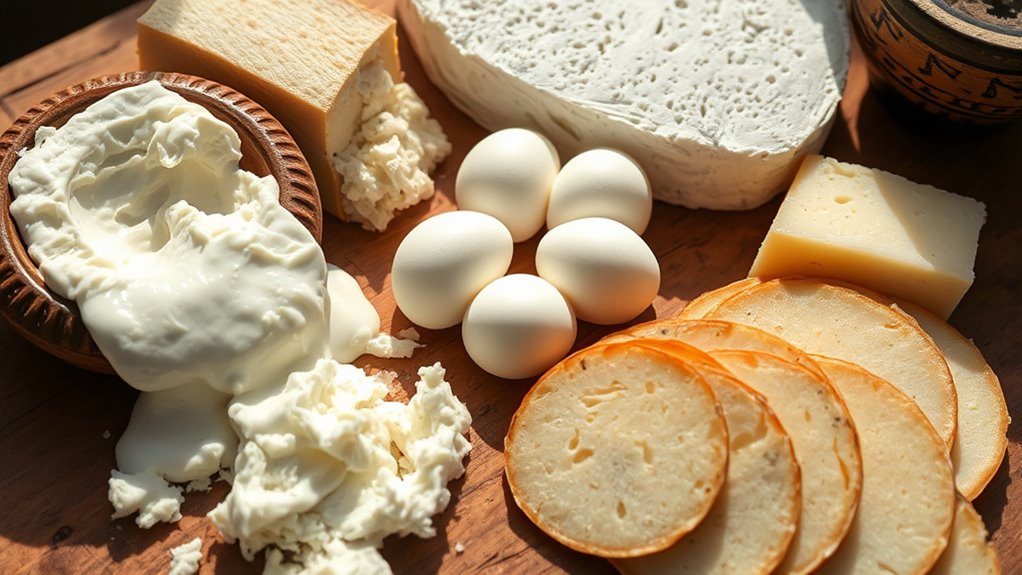
Sardinia’s rich cheese-making heritage is deeply intertwined with its long-standing tradition of producing ricotta cheese. You’ll find that Sardinian ricotta fresca is made from the whey leftover after sheep’s milk cheese production. To improve texture and yield, producers often blend whey with milk or cream. The process involves heating whey to around 65°C, then raising it to 80-82°C for coagulation. The coagulated proteins are collected and drained in conic baskets, then cooled in cold rooms at about 3°C. This ricotta typically weighs around 1.7 kg with a pH between 6.10 and 6.80, ensuring freshness and unique regional flavor. Known as ricotta fresca ovina or ricotta gentile, it’s a staple in Sardinian desserts and culinary traditions.
Exploring Casu Axedu: Sardinia’s Versatile Fresh and Mature Cheese
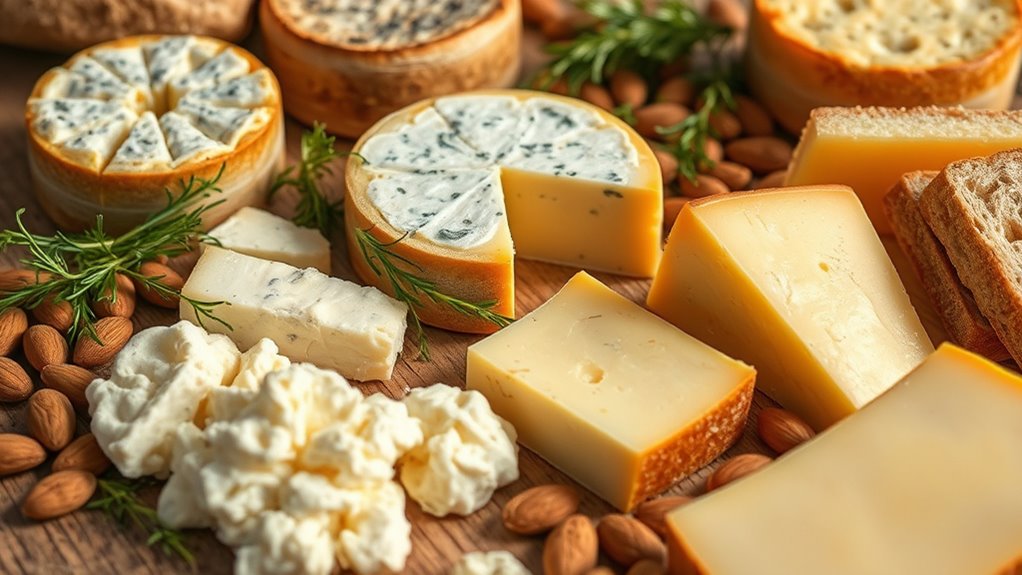
You can enjoy Casu Axedu in both its fresh and mature forms, each offering distinct flavors and textures. Traditional preparation involves heating raw sheep or goat milk and fermenting it with whey, then aging it in brine for added complexity. Serve it as a spread, crumble it over pasta, or add it to soups for a true taste of Sardinian cuisine. Cheese varieties such as Casu Axedu tend to have comparable calorie counts to similar cheeses, making them a flavorful yet manageable addition to your diet. Additionally, understanding the cheese aging process can help you appreciate the development of flavors in both fresh and mature versions.
Fresh vs. Mature Use
Casu Axedu’s versatility shines through its two distinct stages of use, each offering unique culinary experiences. The fresh variety, made from raw sheep’s or goat’s milk, has a soft, creamy texture with a sharp, lactic aroma. It’s best enjoyed the day after production, pairing perfectly with salads, vegetables, or spread on bread. Its mild, sweet profile makes it ideal for light, simple dishes. In contrast, the mature version undergoes months of aging in salt or brine, transforming into a denser, saltier, and more pungent cheese. It develops complex flavors, suitable for grating over pasta, soups, or cooked dishes, adding sharp umami and saltiness. Both forms serve different roles: the fresh for freshness and subtlety, and the mature for depth and robustness in traditional Sardinian cuisine. The preservation method helps extend its shelf life and enhances its flavor development over time.
Traditional Preparation Methods
Traditional preparation of Casu Axedu begins with the careful handling of milk sourced from sheep or goats, which is heated to just over 35°C to initiate coagulation. You then add whey from a previous batch to inoculate and acidify the milk, followed by introducing kid rennet to trigger curd formation within about 30 minutes. Once the curd is set, you break it into rectangles and let it drain overnight on inclined reed structures called su cannissu, often covered with fern leaves. For a softer cheese, you skip extended draining; for a firmer product, you wait up to 48 hours. After shaping, the cheese can be salted on one side, left to dry, and transformed into fiscidu—ideal for grating or cooking—continuing Sardinia’s long cheese-making tradition.
Flavor and Serving Suggestions
The flavor of Casu Axedu varies markedly depending on its age and regional influences, offering a versatile range of tastes from mild and creamy to sharp and pungent. When fresh, it’s soft, smooth, and slightly sweet with a revitalizing, mildly acidic taste that pairs well with salads, vegetables, and Sardinian bread like pistoccu. Serve it in small cubes or spread it on crusty bread to highlight its delicate texture. As it matures, Casu Axedu becomes denser and saltier, ideal for grating over pasta, enriching soups, or filling ravioli. Its pungent flavor adds depth to baked dishes or can be enjoyed alone with olives and cured meats. Its varying textures and flavors make Casu Axedu a versatile ingredient suited for both simple snacks and complex culinary preparations.
Discovering the Unique Pear-Shaped Casizolu
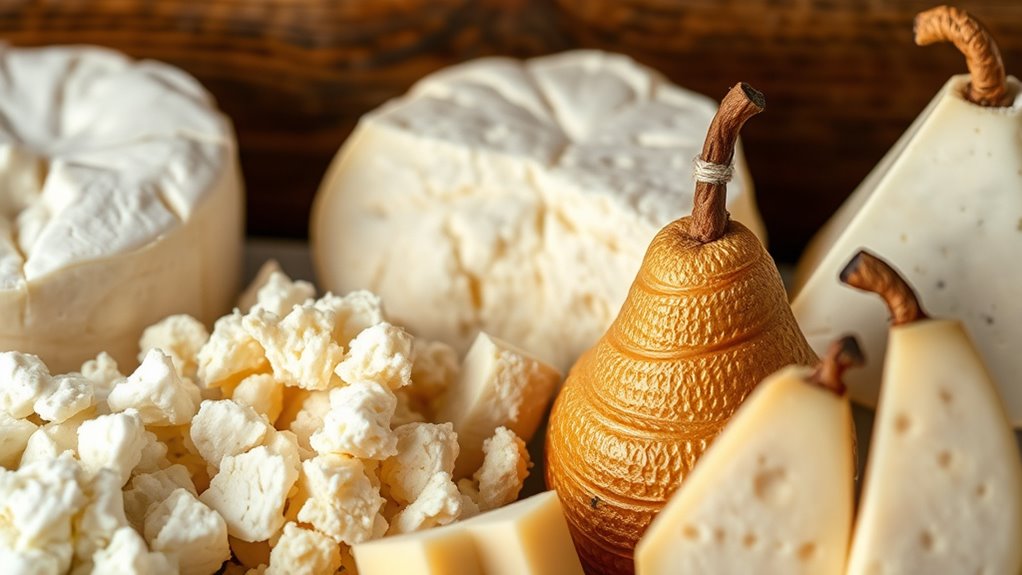
Discovering the unique pear-shaped Casizolu reveals a cheese deeply rooted in Sardinian heritage. Its distinctive form, resembling a large pot-bellied pear, makes it instantly recognizable. Made mainly from native cow’s milk—rare in Sardinia—and crafted through traditional methods, Casizolu’s shape results from kneading curd in hot water. Its rind varies from light yellow to golden with age, while the interior shifts from stringy and creamy when fresh to crumbly and flaky over time. With roots dating back to 1279, this cheese remains artisanal and localized. Its flavors span herbal, milky, grassy, and almond notes, evolving with aging. Casizolu’s cultural significance shines in local festivals and culinary uses, from raw slices to melting in Sardinian dishes. Traditional methods continue to preserve its unique qualities and cultural importance.
The Stringy Delight of Trizza Cheese From Oristano
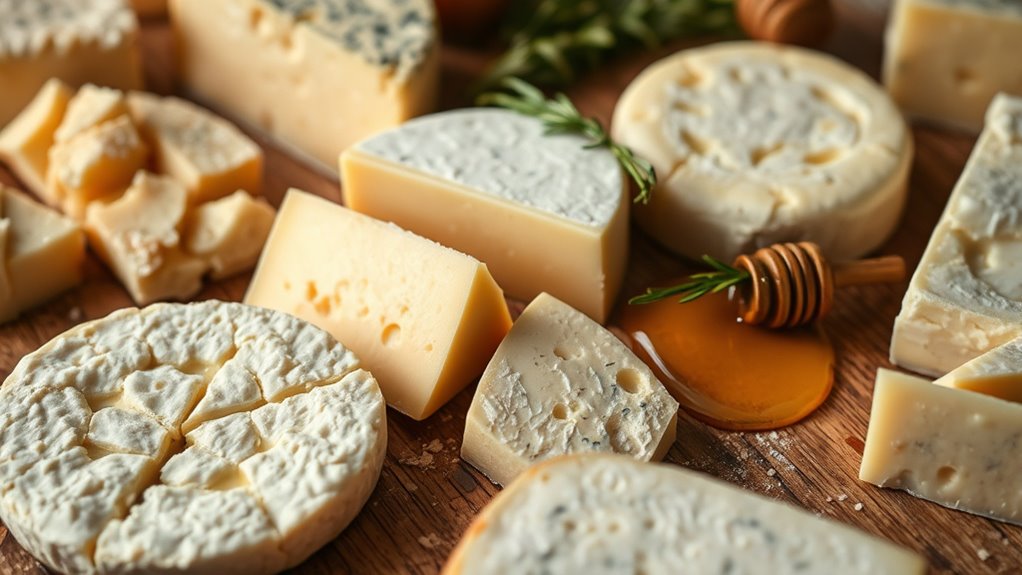
Nestled in the lush landscapes of Oristano and Montiferru, Trizza cheese stands out for its fresh, fibrous texture and unique braided appearance. Made from raw cow’s milk from the native Sardo-Modicana breed, it reflects the region’s rich pastoral traditions. Its name, possibly derived from the Italian “treccia” or Byzantine “Thiriccas,” hints at its braided shape or ancient roots. Trizza is a fresh, stretched-curd cheese, hand-formed into plaits or other traditional shapes, emphasizing its artisanal craftsmanship. With a mild, slightly sweet flavor, it’s best enjoyed soon after production for its elasticity and freshness. Its stringy texture makes it perfect for eating plain, adding to dishes, or serving as a table cheese. Regional cheese varieties like Trizza celebrate Sardinia’s culinary heritage with their simple, authentic charm.
Sardinian Sheep and Goat Cheeses: A Heritage Overview
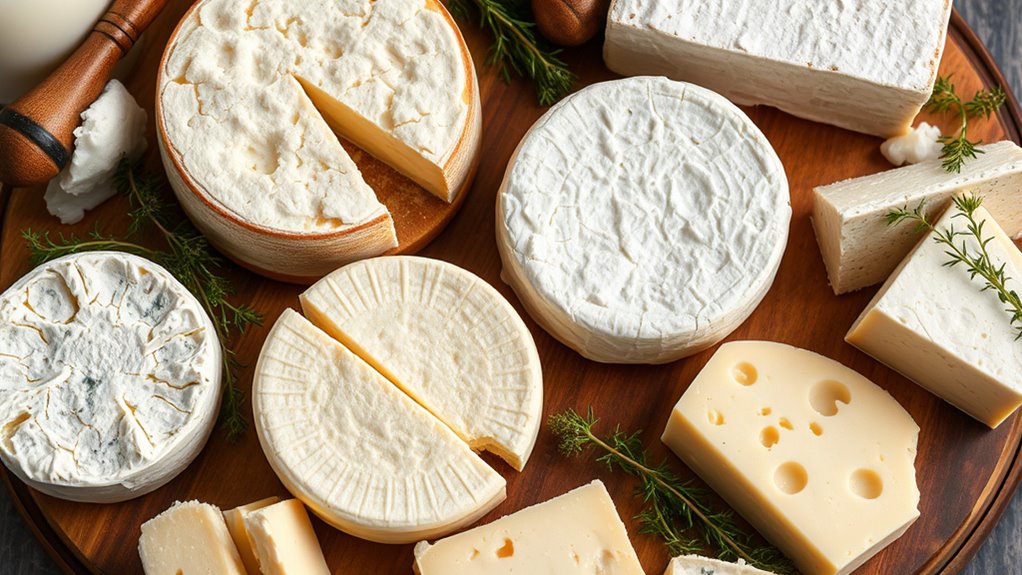
Sardinia’s cheese heritage centers on sheep and goat milk, producing a rich variety of traditional cheeses like Pecorino Romano, Fiore Sardo, and fresh options. You’ll find that local breeds and strict regulations guarantee authentic flavors that reflect the island’s unique environment. This heritage showcases a deep-rooted culture of craftsmanship and regional identity. Made by small, family-run operations that uphold traditional recipes and methods, ensuring the preservation of authentic flavors. The horsepower of electric dirt bikes used in production can influence the texture and aging process of these cheeses, highlighting the importance of traditional craftsmanship combined with modern technology.
Diverse Sheep Milk Cheeses
- Smoked, firm cheeses with complex flavors
- Variations in aging and processing methods
- Unique fermentation traditions like Casu Marzu
- Regional influences shaping cheese characteristics
- Sardinia’s diverse cheese landscape includes regional specialties that reflect its unique cultural heritage and climate.
Unique Goat Milk Varieties
Although goat milk cheese production in Sardinia is relatively recent compared to traditional sheep cheeses, it has quickly become a distinctive part of the island’s culinary heritage. The introduction of goats in the 1960s and the Capra Sarda breed’s unique milk contribute to this. Sardinian goat cheeses are rare in Italy, making them stand out nationally. These cheeses are typically aged for at least 100 days, softening their natural “goatiness” and developing complex flavors. Examples like Pantaleo showcase salty-sweet, floral profiles. Some cheeses blend sheep’s and goat’s milk, shaped with traditional rush molds, and aged over 90 days. The resulting cheeses offer balanced, aromatic flavors and nutritional benefits, often paired with local wines and cured meats, reflecting Sardinia’s rich artisanal cheese-making heritage. Additionally, the limited seasonal production of goat’s milk underscores the rarity and exclusivity of these cheeses. Moreover, the artisanal techniques employed in their making further enhance their unique character and appeal.
Heritage Cheese Traditions
The rich tradition of sheep and goat cheeses in Sardinia reflects generations of craftsmanship and deep cultural roots. You can see this in the island’s reliance on native breeds like the Sarda sheep, whose milk’s unique qualities produce cheeses with intense, piquant flavors and firm textures. Sheep farming remains an essential part of rural life, supporting over 30% of local income and preserving age-old techniques. Traditional methods, such as using raw milk, lamb or goat rennet, and smoking, help maintain authentic flavors. These cheeses, from Fiore Sardo to Casu Axedu, symbolize Sardinia’s heritage and rural identity. Additionally, the Weight of Wind Turbine Blades concept highlights how the use of advanced materials can improve the sustainability of rural industries, including cheese production, by reducing environmental impact.
The Iconic Fiore Sardo: A Spicy Sardinian Classic
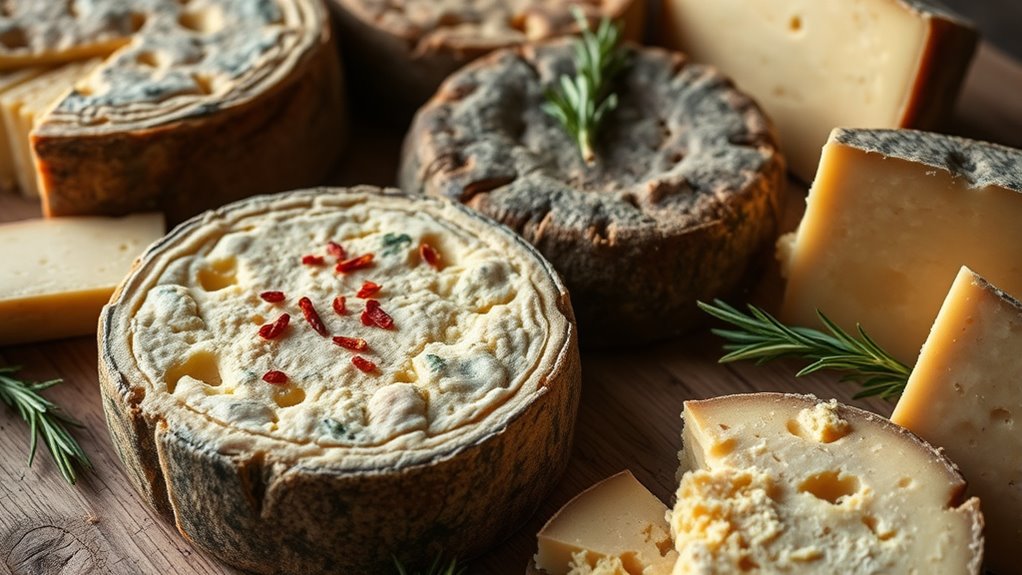
Fiore Sardo stands out as a true emblem of Sardinian culinary tradition, celebrated for its bold, spicy flavor and rustic charm. This ancient cheese, dating back to the Bronze Age, is crafted by shepherds in small mountain huts using raw sheep’s milk from local breeds. Its semi-hard to hard texture becomes crumbly and granular with age, featuring a rounded, barrel-like shape. The natural rind varies from yellow to dark brown and often develops black mold, adding to its rustic appeal. Traditionally smoked over open fires, Fiore Sardo gains a distinctive smoky aroma and flavor. Its sharp, spicy profile, with hints of dried fruits and caramelized nuts, makes it versatile—perfect for grating, melting, or enjoying on its own. This PDO cheese remains a fundamental part of Sardinian heritage. Additionally, chemical processes involved in its aging and smoking contribute to its complex flavor profile and unique texture.
Pecorino Romano and Other Aged Sheep’s Milk Cheeses
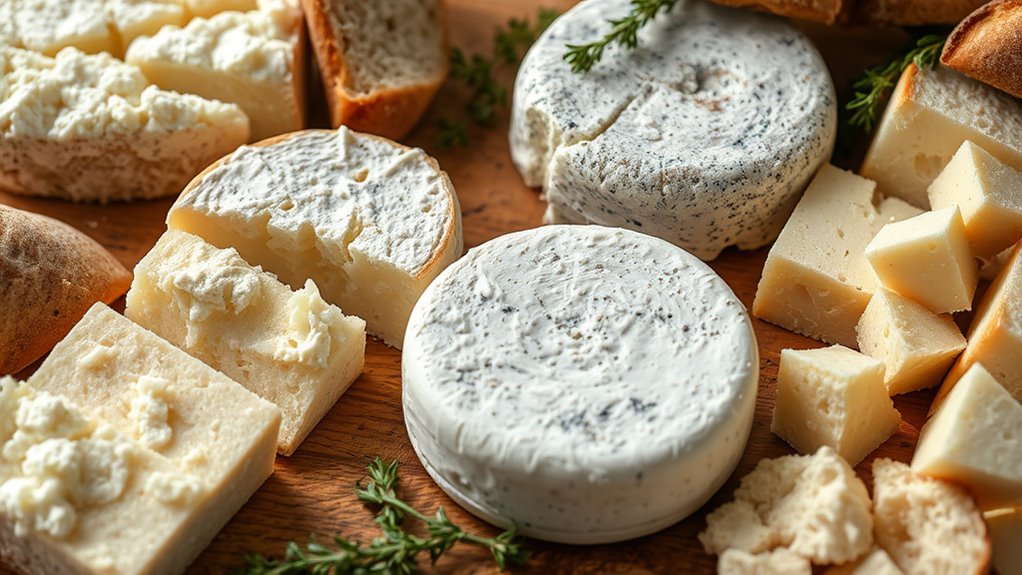
You’ll find that Sardinian aged sheep’s milk cheeses, like Pecorino Romano, offer bold, savory flavors suitable for grating or snacking. These cheeses develop complex profiles, from sharp and salty to slightly sweet, depending on their aging process. Their versatility makes them essential ingredients in both traditional recipes and modern dishes. Pecorino Romano received DOP status in 1996, ensuring its regional origins and traditional production methods are protected and preserved. Additionally, the aging process plays a crucial role in developing the cheese’s distinctive taste and texture, making each variety unique.
Aged Sheep’s Cheeses Varieties
Aged sheep’s milk cheeses from Sardinia showcase a rich variety of flavors and textures shaped by traditional techniques and regional microflora. You’ll find cheeses like Pecorino Romano, Fiore Sardo, and Pecorino Sardo, each with unique aging processes and characteristics. Pecorino Romano is made from unweaned lamb’s milk, aged between 5 to 8 months, developing a sharp, hard texture. Fiore Sardo often has a smoked rind and ages from three months to over a year, gaining nuanced flavors. Pecorino Sardo varies from soft to hard depending on aging, which can last several months or longer. Traditional methods like using lamb rennet, pressing, salting, and aging in controlled environments define these cheeses’ distinct profiles. Milk quality control and aging conditions play a crucial role in achieving the desired flavor and texture profiles of these cheeses. – Use of lamb or kid rennet for coagulation – Rind treatments with olive oil or herbs – Regular turning during aging – Microflora-driven flavor development
Flavor Profiles and Uses
Pecorino Romano and other aged sheep’s milk cheeses from Sardinia offer a fascinating array of flavor profiles that enhance various culinary creations. You’ll notice Pecorino Romano’s sharp tang and salty punch, which deepen with age. Its firm, crumbly texture makes it perfect for grating over pasta, soups, and salads. Younger varieties are milder and creamier, ideal for table use or melting into sauces. The cheese also features nutty undertones and subtle hints of sheep milk, sometimes with a spicy or smoky note. Its bold flavor pairs well with black pepper, cured meats, figs, and honey. You’ll find it adding intensity to traditional dishes like cacio e pepe or modern recipes like lasagna. Its versatility makes Pecorino Romano a key ingredient for savory, umami-rich culinary creations. Aging process influences flavor development. Additionally, the cheese-making process involves traditional methods that contribute to its unique texture and taste, making it a staple in Sardinian cuisine.
The Controversial Charm of Casu Marzu
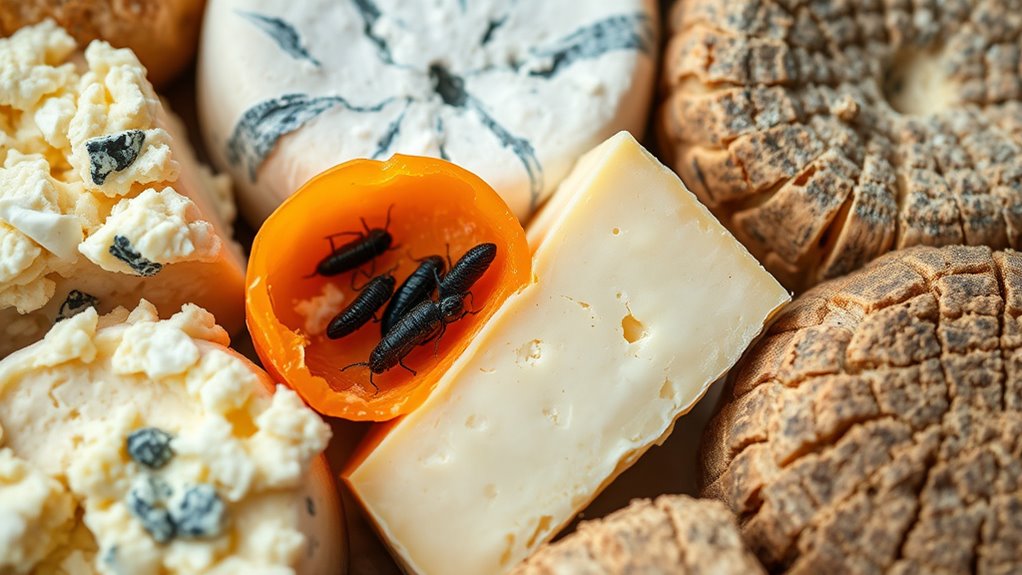
Casu Marzu captivates with its daring blend of tradition and controversy, embodying Sardinia’s culinary ingenuity. Its name, meaning “rotting cheese,” hints at its unique fermentation process involving live larvae. You might find maggots in the cheese, which digest fats and create a pungent, spicy flavor. The larvae’s activity softens the cheese into a creamy, semi-liquid texture, producing complex aromas that rival blue cheeses like Gorgonzola. Despite its cultural significance, Casu Marzu faces legal bans in many countries due to health risks, such as gastrointestinal issues from live larvae. It’s often sold clandestinely, maintaining local tradition. Its strong taste and daring presentation challenge mainstream tastes, making it both a symbol of Sardinian resilience and culinary bravery. European Union bans sale due to health concerns. Traditional Sardinian fermentation with live maggots is a key aspect, but concerns about potential health hazards have led to strict regulations.
Sardinian Cheese Dishes: Zuppa Gallurese and Beyond
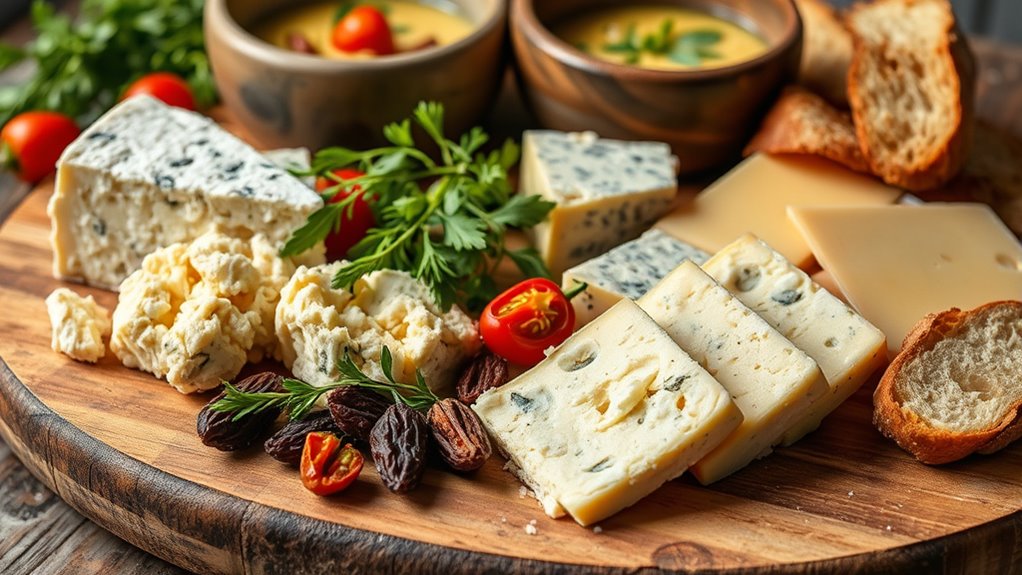
Sardinian cheese dishes showcase the island’s rich culinary heritage, blending local ingredients and traditional techniques to create hearty, flavorful meals. Zuppa Gallurese, originating from Gallura, layers Sardinian bread, pecorino cheese, and mutton broth, then bakes until golden and crusty, resembling a bread pudding. Variations include chicken broth or vegetables like cabbage for added flavor. Beyond Zuppa Gallurese, Sardinia offers dishes like seadas—fried pastries filled with pecorino and lemon zest, drizzled with honey—and culurgiones, herb-filled dumplings. Cheese, especially pecorino and semi-hard casizolu, plays a essential role in these recipes, either melted for texture or grated for seasoning. These dishes reflect Sardinia’s pastoral roots, using local ingredients to craft comforting, traditional flavors that celebrate the island’s cheese heritage. Cheese varieties also influence the island’s culinary traditions, highlighting the importance of local dairy products in Sardinian cuisine.
Preserving Sardinian Cheese Heritage: Slow Food and Traditional Methods
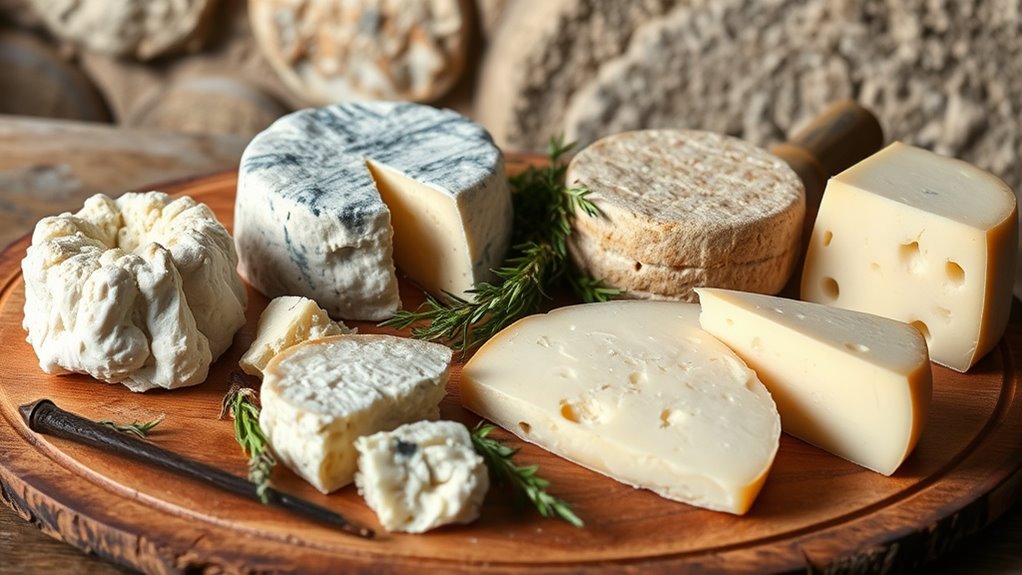
Preserving traditional Sardinian cheese-making methods is crucial for safeguarding the island’s rich culinary heritage. These techniques, rooted in centuries-old practices, rely on local ingredients and artisanal skills that define Sardinian identity.
- Using raw, whole sheep’s milk to maintain natural microflora.
- Employing copper boilers and hand tools like the mòriga to uphold authenticity.
- Aging cheeses on cane racks near hearth fires for distinctive smoke and drying effects.
- Periodic greasing with wine vinegar, olive oil, and salt to protect and flavor the cheese.
The region’s isolated inland locations help preserve these methods by limiting industrial influence.
The Slow Food movement plays an important role by supporting these heritage practices through Presidia programs, fostering community knowledge, and promoting sustainable, traditional production. This effort ensures these unique cheeses continue to thrive for future generations.
Frequently Asked Questions
What Are the Main Differences Between Sardinian Ricotta Varieties?
You’re asking about the main differences between Sardinian ricotta varieties. Smoked matured ricotta has a soft, buttery texture with a smoky aroma, while ricotta mustia is firmer, also smoked but more solid and versatile. Ricotta salata is aged, pressed, and salted, making it firm, dry, and perfect for grating. Each offers unique flavors and textures that suit different culinary uses, reflecting Sardinia’s rich cheese tradition.
How Is Casu Axedu Traditionally Prepared and Enjoyed?
You see Casu Axedu as simple cheese, yet its tradition runs deep. You start by heating sheep or goat milk to 35-36°C, then add kid’s rennet to coagulate it. The curd is broken, drained overnight, and sometimes soaked in salty brine. Enjoy it fresh with bread or aged grated over pasta, or in soups and ravioli. Its long-standing method and versatile use reflect Sardinia’s rich culinary heritage.
What Makes Casizolu a Rare and Endangered Sardinian Cheese?
You’ll find Casizolu is rare and endangered because it’s made from Sardinian cow’s milk, which is uncommon in a sheep-dominated dairy culture. Its artisanal, traditional methods are complex and mostly home-based, limiting production and commercial availability. The cheese’s fragile supply chain, limited market presence, and dependence on local practices make it hard to scale, putting it at risk of disappearing without ongoing conservation efforts.
How Is Trizza Cheese Traditionally Served and Used in Sardinian Cuisine?
Imagine tasting a slice of Sardinia’s heart, a delicate string cheese called Trizza. You’ll find it woven into braids or served fresh after production, highlighting its soft, rich texture. You can enjoy it plain with rustic bread, as a snack, or paired with local wines. Its simple, fresh flavor makes it perfect for light, raw dishes, especially during Lent, celebrating Sardinian traditions with every bite.
What Are the Unique Characteristics of Sardinian Goat and Mixed Milk Cheeses?
You’ll find Sardinian goat and mixed milk cheeses are truly distinctive. They showcase intense aromatic notes from goats grazing on wild Mediterranean flora. Their textures range from soft and creamy to semi-hard, depending on aging. Mixed-milk varieties blend the sharpness of goat with the sweetness of sheep or cow milk, creating nuanced flavor profiles. Emphasizing traditional methods, these cheeses often have a rich, earthy aroma with a complex, harmonious taste that reflects Sardinia’s unique terroir.
Conclusion
So, next time you think cheese is just cheese, remember Sardinia’s dairy delights. From mischievous Casu Marzu to elegant Ricotta, this island proves that cheese isn’t just food—it’s a cultural rebellion. Embrace the quirks, savor the stories, and maybe, just maybe, consider a cheese tour instead of a wine one. After all, who needs sophistication when you’ve got Sardinian cheese daring you to try it?
